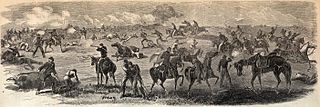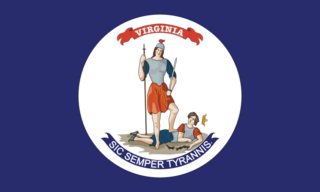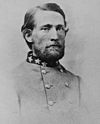
The Battle of Dranesville was a small battle during the American Civil War that took place between Confederate forces under Brigadier General J. E. B. Stuart and Union forces under Brigadier General Edward O. C. Ord on December 20, 1861, in Fairfax County, Virginia, as part of Major General George B. McClellan's operations in northern Virginia. The two forces on similar winter-time patrols encountered and engaged one another in the crossroads village of Dranesville. The battle resulted in a Union victory.

The Battle of Upperville took place in Loudoun County, Virginia on June 21, 1863 during the Gettysburg Campaign of the American Civil War.

The Loudoun Valley is a small, but historically significant valley in the Blue Ridge Mountains located in Loudoun County in Northern Virginia in the United States.

The Battle of Mile Hill was a cavalry skirmish during the American Civil War, that took place just north of Leesburg, Virginia, on September 2, 1862. It preceded the occupation of the town by the Army of Northern Virginia just prior to its crossing of the Potomac River starting the Maryland Campaign.

John W. Mobberly, also known as John Mobley or Morbly, was a Confederate guerrilla who operated in the Loudoun Valley and Between the Hills region of Loudoun County, Virginia during the American Civil War. He also served as regular soldier in Elijah V. White's 35th Battalion, Virginia Cavalry, nicknamed the "Comanches." Mobberly is sometimes reported as serving under John Mosby, although this is not grounded in fact. His legacy is surrounded in controversy as Federal soldiers and Union sympathizers in Loudoun County accused him of committing war atrocities, including slave-rustling, while pro-Southern Loudoun residents claimed him to be a hero, second only to Mosby in local popularity.
Loudoun County in the Civil War —Loudoun County, Virginia, was destined to be an area of significant military activity during the American Civil War. Located on Virginia's northern frontier, the Potomac River, Loudoun County became a borderland after Virginia's secession from the Union in early 1861. Loudoun County's numerous Potomac bridges, ferries and fords made it an ideal location for the Union and Confederate armies to cross into and out of Virginia. Likewise, the county's several gaps in the Blue Ridge Mountains that connected the Piedmont to the Shenandoah Valley and Winchester were of considerable strategic importance. The opposing armies would traverse the county several times throughout the war leading to several small battles, most notably the Battle of Balls Bluff.
The Battle of Marianna was a small but significant engagement on September 27, 1864, in the panhandle of Florida during the American Civil War. The Union destruction against Confederates and militia defending the town of Marianna was the culmination of a substantial Federal cavalry raid into northwestern Florida. Ultimately the Union retreated back to Fort Barrancas.

The 43rd Battalion, Virginia Cavalry, also known as Mosby's Rangers, Mosby's Raiders, or Mosby's Men, was a battalion of partisan cavalry in the Confederate army during the American Civil War. Noted for their lightning strike raids on Union targets and their ability to consistently elude pursuit, the Rangers disrupted Union communications and supply lines.

The Skirmish at Miskel Farm, also known as the Fight at Miskel Farm or Gunfight at Miskel Farm, was a skirmish during the American Civil War. It took place April 1, 1863, near Broad Run in Loudoun County, Virginia, between Mosby's Rangers and the 2nd Pennsylvania Cavalry as part of Mosby's operations in Northern Virginia. The 2nd Pennsylvania surprised and attacked the Rangers, who were bivouacked on the farm of Thomas Miskel. The Rangers successfully defended the attack and subsequently routed the 2nd Pennsylvania, inflicting heavy casualties and taking many prisoners.

The Battle of Unison or Battle of Union refers to a series of American Civil War cavalry skirmishes in Loudoun County, Virginia, between October 31 – November 2, 1862, between the Confederate forces of J.E.B. Stuart and various units of the Union Army of the Potomac. Although driven from the field in individual engagements, Stuart accomplished his mission to delay the enemy and screen the movements of the retreating Army of Northern Virginia.
The Battle of Loudoun Heights was a small cavalry skirmish during the American Civil War between John Mosby's Rangers and Major Henry A. Cole's 1st Potomac Home Brigade Maryland Cavalry on January 10, 1864, in Loudoun County, Virginia. Cole's Cavalry successfully defended a night raid against their camp on Loudoun Heights. The fight was one of the first engagements in which Union forces held their own against Mosby's vaunted partisans.

Heaton's Crossroads, also known as the Purcellville Wagon Raid, was an American Civil War skirmish that took place between Federal cavalry under Brig. Gen. Alfred N. Duffié and Confederate infantry under Maj. Gen. John C. Breckinridge on July 16, 1864, near present-day Purcellville, Virginia in Loudoun County as part of the Valley Campaigns of 1864. The action was tactically inconclusive.

The Battle of Charlestown was a small engagement between Confederate cavalry forces under Brig. Gen. John D. Imboden and the Union forces under Col. Benjamin L. Simpson on October 18, 1863, at Charlestown, West Virginia, as part of the Bristoe and Mine Run Campaigns, resulting in a Confederate victory.

The Action at Mount Zion Church was a cavalry skirmish during the American Civil War that took place on July 6, 1864. The skirmish was fought between Union forces under Major William H. Forbes and Confederate forces under Colonel John S. Mosby near Aldie in Loudoun County, Virginia as part of Mosby's Operations in Northern Virginia. After successfully raiding the Union garrison at Point of Rocks, Maryland, Mosby's Rangers routed Forbes's command, which had been sent into Loudoun County to engage and capture the Rangers. The fight resulted in a Confederate victory.

The Fight at Waterford was a small skirmish during the American Civil War that took place in Waterford, Virginia on August 27, 1862 between the local partisan cavalry units of White's Rebels, fighting for the Confederates, and the Loudoun Rangers fighting for the Union. The Rebels surprised and routed the newly formed Loudoun Rangers in their camp at Waterford, capturing nearly the whole unit before subsequently paroling them, thus resulting in a Confederate victory. The action was the first significant partisan fighting in Loudoun County.

The Fight at Aldie was a small cavalry skirmish between Confederate forces under Major John S. Mosby and Union forces under Major Joseph Gilmore and Captain Franklin T. Huntoon in Aldie, Virginia, on March 2, 1863, as part of Mosby's Operations in Northern Virginia during the American Civil War. The fight which resulted in a Confederate victory was significant in that it was the first action of Mosby's Rangers within their operating territory in the central Loudoun Valley. In the fight Mosby and his men displayed many characteristics that would become their hallmark including the attack on numerically superior force while inflicting disproportionate casualties to those received.

The Affair at Glenmore Farm was a small cavalry skirmish that took place October 16, 1862 in Loudoun County, Virginia between Confederate forces under First Lieutenant Frank Myers and Union forces under General John Geary during the American Civil War. The skirmish resulted in a Union victory.

The Harmony Skirmish was a small engagement of the American Civil War between Confederate forces under Colonel John Mosby and Union forces under Colonel Marcus Reno on March 21, 1865 near the village of Harmony in Loudoun County, Virginia. A union raiding party, that was sent into Loudoun County to eliminate Confederate partisans, was ambushed by Mosby's Rangers near the village of Harmony. After inflicting light casualties on the Federals, the Rangers were unable to drive off the numerically superior and better equipped force and were compelled to withdrawal. The skirmish, which was the last major action of the war within Loudoun, was tactically inconclusive.

The Burning Raid was a Union military raid conducted in the Loudoun Valley of Loudoun and Fauquier counties in Virginia in November and December 1864 during the American Civil War. It was aimed at destroying the forage on which Confederate partisans operating in the area, specifically Mosby's Rangers, subsisted as well as at breaking the will of the citizens of the area for supporting the partisans.

Originally organized as the 1st Potomac Home Brigade Cavalry, "Cole's Cavalry" was formed under the guidance of Henry A. Cole. There are also references to it being designated as Cole's 1st Volunteer Maryland Cavalry. The unit, a battalion, originally consisted of four companies, A, B, C & D and was initially enlisted between August 10 and November 27, 1861.











